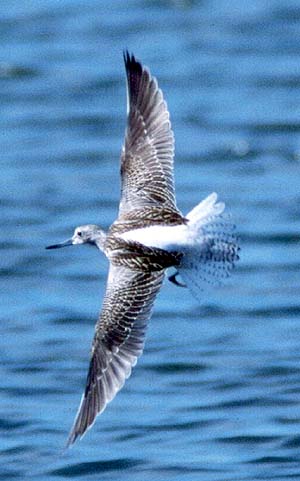An obvious Tringa about the size and shape of adjacent Greater Yellowlegs, but with dull olive-green
legs and a large white patch up the
back. The rear end was very tapered, but there was almost no primary projection beyond the folded tertials. It
fed actively bobbing its head and tail in the manner of the adjacent yellowlegs, but with more energy. Often the
Common Greenshank would fly to a new location where it would forage alone but invariably the pack of Greater Yellowlegs,
and one Lesser Yellowlegs would eventually follow suit.
The bird was in juvenal plumage, showing crisp buffy edges to the dark-brown or blackish centers of the wing coverts and tertials. This pattern differed notably from adjacent Greater and Lesser yellowlegs (see photo right; Lesser Yellowlegs is in front). The yellowlegs showed separate whitish wedge-shaped markings along the margins of these feathers, imparting a spotted appearance. The greenshank had the coverts fringed narrowly with buff, lacking the small spots evident on the yellowlegs. The tertials on the greenshank did have fringes made from small connecting saw-tooth markings, but this pattern differed from that of the yellowlegs in that the markings were continuous on the greenshank and not separated from each other. Also the markings were much smaller, so that from a distance, the "teeth" were not evident. The finely toothed pattern was visible only at very close range. Very faint dark cross-bars could also be seen on the tertials, but only at very close range. The lesser coverts were black and contrasted strongly with the white underparts.
 The back and breast were suffused
with a warm tawny-brown, compared to much colder grayer looking yellowlegs. The greenshank also showed a fairly
obvious tawny patch on the sides of the breast.
The back and breast were suffused
with a warm tawny-brown, compared to much colder grayer looking yellowlegs. The greenshank also showed a fairly
obvious tawny patch on the sides of the breast.
The eye was dark, with a pale area over the eye extending to the bill. This pale area contrasted with a gray crown, which came to a point just above the forehead, forming a widow's peak. This was evident only when the bird was facing the observer. Otherwise, the head and the side of the necked were marked coarsely with diffused grayish streaks. Within the streaking, a few whitish streaks were evident on the side of the neck and nape. The fore-neck was whitish, blending with the diffuse neck streaking and the underparts were all white except for the buffy patches on the sides of the breast mentioned earlier.
The tail was white with narrow dark cross-bars at the tip. In flight the whole back appeared snow white, showing a dowitcher pattern. In flight underwings appeared dark with some white in the underwing coverts.
The bill was similar to Greater Yellowlegs, slightly upturned and with a relatively heavy gray base. However it appeared to be a little shorter and perhaps more blunt at the tip than the Greater Yellowlegs. The bird seemed slightly larger than some of the adjacent Greater Yellowlegs, and notably broader in the body than the yellowlegs.
The leg color was an easy feature to use to pick out the bird. The legs looked dark from a distance while the yellow color of the Greater Yellowlegs was very evident under almost all lighting conditions.
The bird called several times. Usually "tew - tew" with both notes the same, but sometimes "tew-tew-tew" with the last note slightly lower. Occasionally it gave a three-note call in which all three notes seemed the same. In general I thought the notes were slightly more mellow and more widely spaced than similar calls given by Greater Yellowlegs. This difference was mentioned to me by Jude Power in our telephone conversation that morning.
 On the morning of 28 August, I received
a phone call from Jude Power informing me that the Common Greenshank found the day before by Ken Irwin was still
present at the mouth of the Mad River. Based on this information, Robbie Fischer and I decided to drive up in hopes
of seeing this rarity, a first state record. We arrived mid-afternoon and received a phone call on my cell phone
from Jan Andersen, that the bird was being seen from the yard of our mutual friend, Linda Doerflinger on Ocean
Avenue in McKinleyville. As we arrived, Bob and Carol Yutzy were just leaving. They informed us that the bird was
still there. Linda had her telescope set up in the back yard and kindly showed us the bird which was foraging along
the far bank of the Mad River, often in company with 3 Greater Yellowlegs.
On the morning of 28 August, I received
a phone call from Jude Power informing me that the Common Greenshank found the day before by Ken Irwin was still
present at the mouth of the Mad River. Based on this information, Robbie Fischer and I decided to drive up in hopes
of seeing this rarity, a first state record. We arrived mid-afternoon and received a phone call on my cell phone
from Jan Andersen, that the bird was being seen from the yard of our mutual friend, Linda Doerflinger on Ocean
Avenue in McKinleyville. As we arrived, Bob and Carol Yutzy were just leaving. They informed us that the bird was
still there. Linda had her telescope set up in the back yard and kindly showed us the bird which was foraging along
the far bank of the Mad River, often in company with 3 Greater Yellowlegs.